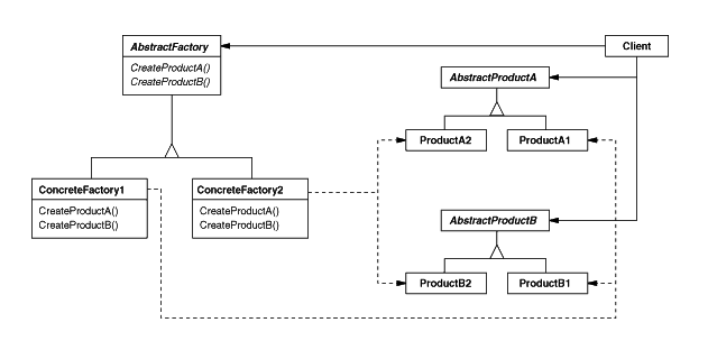1. Abstract Factory
1. Abstract Factory
- Intent:
- Provide an interface for creating families of related or dependent objects without specifying their concrete classes.
- Also Known As:
- InterViews uses the “Kit” suffix to denote AbstractFactory classes. It defines WidgetKit and DialogKit abstract factories for generating look-and-feel-specific user interface objects.
- Applicability:
- a system should be independent of how its products are created, composed, and represented.
- a system should be configured with one of multiple families of products.
- a family of related product objects is designed to be used together, and you need to enforce this constraint.
- you want to provide a class library of products, and you want to reveal just their interfaces, not their implementations.
- Related Patterns:
- Factory Method
- Prototype
- Singleton

- Participants:
- AbstractFactory (WidgetFactory)
- declares an interface for operations that create abstract product objects.
- ConcreteFactory (MotifWidgetFactory, PMWidgetFactory)
- implements the operations to create concrete product objects.
- AbstractProduct (Window, ScrollBar)
- declares an interface for a type of product object.
- ConcreteProduct (MotifWindow, MotifScrollBar)
- defines a product object to be created by the corresponding concrete factory.
- implements the AbstractProduct interface.
- Client
- uses only interfaces declared by AbstractFactory and AbstractProduct classes.
- AbstractFactory (WidgetFactory)
- Consequences:
- It isolates concrete classes.
- It makes exchanging product families easy.
- It promotes consistency among products.
- Supporting new kinds of products is difficult.
- Sample:
We’ll apply the Abstract Factory pattern to creating the mazes
//Class MazeFactory can create components of mazes. It builds rooms, walls, and
doors between rooms.
class MazeFactory {
public:
MazeFactory();
virtual Maze* MakeMaze() const
{ return new Maze; }
virtual Wall* MakeWall() const
{ return new Wall; }
virtual Room* MakeRoom(int n) const
{ return new Room(n); }
virtual Door* MakeDoor(Room* r1, Room* r2) const
{ return new Door(r1, r2); }
};
//CreateMaze hard-codes the class names, making it difficult to create mazes with different components.
//Here's a version of CreateMaze that remedies that shortcoming by taking a MazeFactory as a parameter:
Maze* MazeGame::CreateMaze (MazeFactory& factory) {
Maze* aMaze = factory.MakeMaze();
Room* r1 = factory.MakeRoom(1);
Room* r2 = factory.MakeRoom(2);
Door* aDoor = factory.MakeDoor(r1, r2);
aMaze->AddRoom(r1);
aMaze->AddRoom(r2);
r1->SetSide(North, factory.MakeWall());
r1->SetSide(East, aDoor);
r1->SetSide(South, factory.MakeWall());
r1->SetSide(West, factory.MakeWall());
r2->SetSide(North, factory.MakeWall());
r2->SetSide(East, factory.MakeWall());
r2->SetSide(South, factory.MakeWall());
r2->SetSide(West, aDoor);
return aMaze;
}
//We can also create EnchantedMazeFactory, a factory for enchanted mazes, by subclassing MazeFactory.
class EnchantedMazeFactory : public MazeFactory {
public:
EnchantedMazeFactory();
virtual Room* MakeRoom(int n) const
{ return new EnchantedRoom(n, CastSpell()); }
virtual Door* MakeDoor(Room* r1, Room* r2) const
{ return new DoorNeedingSpell(r1, r2); }
protected:
Spell* CastSpell() const;
};
//suppose we want to make a maze game in which a room can have a bomb set in it.
class BombedMazeFactory : public MazeFactory {
public:
BombedMazeFactory();
Wall* BombedMazeFactory::MakeWall () const
{ return new BombedWall;}
Room* BombedMazeFactory::MakeRoom(int n) const
{return new RoomWithABomb(n);}
protected:
Spell* CastSpell() const;
};
//To build a simple maze that can contain bombs
MazeGame game;
BombedMazeFactory factory;
game.CreateMaze(factory);
Java Implementation:
// Interface
public interface AbstractFactory {
public ProductA factoryA();
public ProductB factoryB();
}
public interface ProductA {
...
}
public interface ProductB {
...
}
//Concrete Classes
public class ConcreateFactory1 implements AbstractFactory {
@Override
public ProductA factoryA() {
return new ConcreateProductA1();
}
@Override
public ProductB factoryB() {
return new ConcreateProductB1();
}
}
public class ConcreateFactory2 implements AbstractFactory {
@Override
public ProductA factoryA() {
return new ConcreateProductA2();
}
@Override
public ProductB factoryB() {
return new ConcreateProductB2();
}
}
public class ConcreateProductA1 implements ProductA {
...
}
public class ConcreateProductA2 implements ProductA {
...
}
public class ConcreateProductB1 implements ProductB {
...
}
public class ConcreateProductB2 implements ProductB {
...
}
